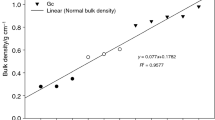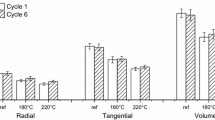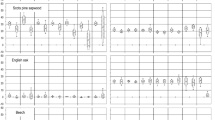Abstract
In order to study the influence of high temperature on wood properties, boards from Scots pine were dried at three different schedules, two high-temperature-schedules (HT) and one at low temperature (LT). Strength properties as hardness, cleavage- and shear-strength were determined and sorption/desorption behaviour were studied. Material was analysed concerning carbohydrate and extractive content and mould growth test at wooden surfaces. Results showed a significant influence of temperature on decreasing shear strength and equilibrium moisture content (EMC) in sorption/desorption tests. Sorption/desorption tests resulted in up to 2.4% lower EMC for HT dried material at the same climate compared with LT-dried and the hysteresis effect seems to be more pronounced in HT-dried material. Mould growth test showed an inhibiting effect of HT-drying on mould susceptibility at wooden surfaces. Carbohydrate analysis revealed a lower content of hemicelluloses in HT-dried boards which indicates a decomposition of the hemicelluloses explaining the decrease in shear strength and hygroskopic moisture uptake seen in the HT dried boards.
Zusammenfassung
Um den Einfluß erhöhter Temperatur auf die Holzeigenschaften zu bestimmen, wurden Bretter aus nordischer Kiefer nach verschiedenen Trocknungsplänen, zwei bei hoher Temperatur, einer bei niedriger Temperatur, getrocknet. Härte, Bruch- und Scherfestigkeit wurden bestimmt sowie das Sorptions- und Desorptionsverhalten untersucht. Zuckeranalysen, Bestimmung des Extraktstoffgehalts und des Pilzwachstums an der Oberfläche wurden an den Proben durchgeführt. Die Temperatur hatte einen signifikanten Einfluß auf die Scherfestigkeit und die Gleichgewichtsfeuchte. Die Sorptions-/Desorptionsversuche führten bei gleichem Konditionierungsklima zu einer um 2,4% niedrigeren Endfeuchte der HT-getrockneten Proben, bei denen auch der Hysterese-Effekt stärker ausgeprägt erschien. Pilzwachstumstests zeigten eine Hemmung der Pilzentwicklung an der Oberfläche der HT-getrockneten Proben. Bei diesen Proben ließen die Zuckeranalysen auch einen Abbau der Hemicellulosen erkennen, wodurch die Abnahme der Scherfestigkeit und der Feuchteaufnahme der HT-getrockneten Proben erklärt werden kann.
Similar content being viewed by others
6 References
Espenas, L. D. 1971: Shrinkage of Douglas-Fir, Western Hemlock and Red Alder as affected by drying conditions. Forest Prod. J. 21(6): 44–46
Hillis, W. E. 1984: High temperature and chemical effects on wood stability. Wood Sci. Technol. 18: 281–293
Hinterstoisser, B.; Weingärtner, J.; Praznik, W. 1992: Influence of wood drying processes on the carbohydrate matrix of wood of Picea Abies. Proceedings 3rd IUFRO international wood drying conference Vienna
Kininmonth, J. A. 1976: Effect of timber drying temperature on subsequent moisture and dimensional changes. N. Z. J. For. Sci. 6(1): 101–107
Morén, T.;Sehlstedt-Persson, M. 1990: Högtemperaturtorkning av byggnadsvirke. Teknisk rapport 1990: 27T Högskolan i Luleå, Inst. träteknik, Skellefteå. (In Swedish)
Price, E. W.;Koch, P. 1980: Kiln time and temperature affect shrinkage, warp and mechanical properties of Southern Pine lumber. Forest. Prod. J. 30(8): 41–47
Teischinger, A. 1992: Effect of different drying temperatures on selected physical wood properties. Proceedings 3rd IUFRO international wood drying conference Vienna
Terziev, N.;Boutelje, J.;Söderström, O. 1993: The influence of drying schedules on the redistribution of low-molecular sugars in Pinus sylvestris L. Holzforschung 47(1): 3–8
Terziev, N. 1994: Personal communication
Theander, O.;Bjurman, J.;Boutelje, J. B. 1993: Increase in the content of low-molecular carbohydrates at lumber surfaces during drying and correlations with nitrogen content, yellowing and mould growth. Wood Sci. Technol. 27: 381–389
Author information
Authors and Affiliations
Rights and permissions
About this article
Cite this article
Sehlstedt-Persson, S.M.B. High-temperature drying of scots pine. A comparison between HT- and LT-drying. Holz als Roh-und Werkstoff 53, 95–99 (1995). https://doi.org/10.1007/BF02716400
Issue Date:
DOI: https://doi.org/10.1007/BF02716400




